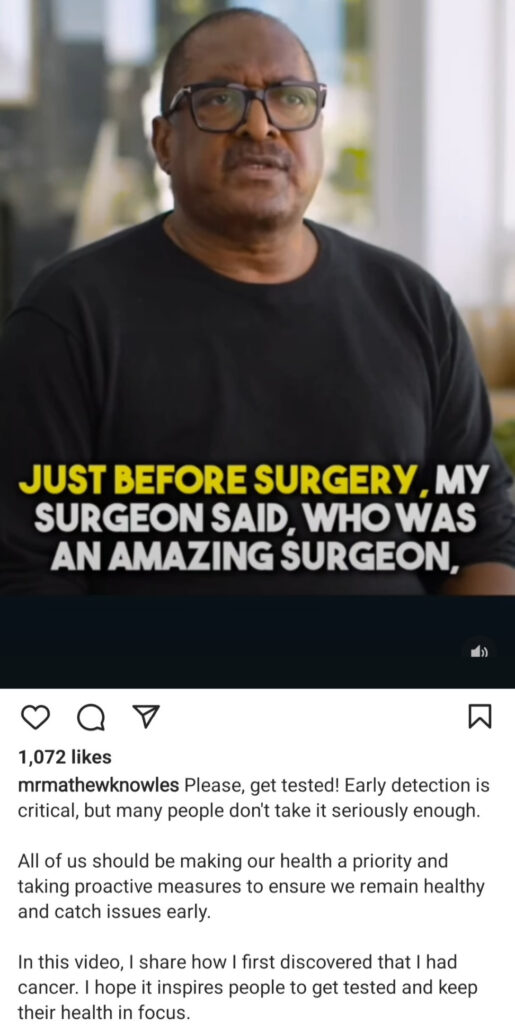Beyoncé’s Dad, Mathew Knowles Spreads Awareness For Male Breast Cancer As He Narrates How He Discovered He Had The Disease

Breast cancer can happen to anyone. And Mathew Knowles wants to remind men, in particular, to watch out for symptoms of the disease.
Knowles is the father of singers Beyoncé and Solange, an entertainment powerhouse and, perhaps less widely known, a male breast cancer survivor.
Since his cancer experience, the 70-year-old “male chest cancer survivor,” as he prefers to be called, has been on a mission to spread awareness for the disease and advocate for men to be proactive about their health.
In a recent Tweet, Knowles revealed how he discovered he had breast cancer.
Mr Knowles said he began to notice that the white t-shirts his wife, Gena Avery, bought for him had red dots on them. He initially thought it had to do with the t-shirts because the red dots were always on the same spot on all the t-shirts.
He said he then asked his wife about the “black dots of blood” on his t-shirt and she told him that she also noticed those black dots of blood on his side of their bed sheets. He said in the video:
“My wife had bought some new T-shirts, white T-shirts, for me and imagine a white sheet of paper and you had a red pen and you have maybe four or five dots on it. And I said, ‘Maybe it’s something to do with these shirts, T shirts, my wife bought.
I said, ‘I keep seeing these black dots of blood.’ And she says, ‘Oh, I cleaned the sheets the last couple of days and there were these black dots of blood on your side of the bed.'”
Mr Knowles further said he recalled that discharge of blood is one of the signs of breast cancer in men so he called his physician and said to him, “I need to get a mammogram”.
“Now, training in the ’80s, there was one day that we had male breast cancer. And I remember that this discharge was one of the signs of what I call male chest cancer, or breast cancer, and so I immediately call my referring physician.”
He got a mammogram the next day and then a biopsy, which showed he had breast cancer. He said:
“We got one immediately, like the next day, and then we got a biopsy. And then a few days later I had surgery, and I had a mastectomy.”
Knowles is now cancer-free. He explained that just before surgery, his surgeon told him there is one more test he wants him to undergo. When the result came out, it showed he was “BRCA2 mutated”.
Mutations in the BRCA2 gene are associated with an increased risk of breast cancer in both men and women, as well as several other types of cancer, according to MedlinePlus.
Sadly, breast cancer is the same disease that claimed the lives of Mathew Knowles’ mother, aunt and great aunt.
Mr Knowles then begged men to get tested because they too are susceptible to breast cancer.
Knowles was diagnosed with male breast cancer in 2019. After his diagnosis, he also found out that he carries the BRCA2 (BReast CAncer 2) gene mutation which means that his children had a 50 percent chance of also carrying the gene.
Thankfully, Knowles has previously said Beyoncé and Solange have tested negative for the gene mutation.
In a previous conversation with SurvivorNet, Knowles talked about wanting to inform men that they, too, can get breast cancer, but also wanting to urge the African American community to take control of their health.
“I felt I was worth it,” he told SurvivorNet. “I had that self-care.”
He says that distrust of the healthcare industry among people of color “goes back all the way to slavery.” He wants people of color to move forward for the sake of cancer prevention and overall healthcare. He said:
“If there is a new day, I think we have to understand that people of color are in high positions in the medical profession and working vigorously to make change.
We can’t change what happened years ago, but we can effect change of what happens today. It’s about early detection… When we’re saying, ‘Well, I’m not going to go to the doctor because of what they did 10 years or 20 years ago,’ you’re only hurting yourself. You’re the one that will have the repercussions of not getting early detection.”
And when looking specifically at male breast cancer, Knowles is right to urge Black men, in particular, to be aware of the disease.
Despite the fact that breast cancer is about 70 times less common among Black men than Black women, according to American Cancer Society statistics, both Black men and Black women tend to have a worse prognosis when it comes to the breast cancer. (Breast cancer is about 100 times less common among white men than among white women.) Men, in general, also tend to ignore breast cancer symptoms more than women which can be very dangerous.
If you ever feel like something is off, and there might be cause for concern, it’s important to promptly consult your doctor.
Men tend to feel a sense of shame when it comes to a breast cancer diagnosis, but there is no reason to be ashamed.
Taking care of your body should be the priority, and that means addressing all issues with your doctor – even if they feel hard to talk about.
ALSO SEE: Why Nigerian Men Above 50 Years Need To Know The Early Symptoms Of Prostate Cancer – Experts
Possible Risk Factors:
- Age. Breast cancer risk increases with age, and most cancers are found in patients over 50. The average age of a man diagnosed with breast cancer is 72.
- Family history. Men with close blood relatives who have had breast cancer are at higher risk for the disease.
- Genetic mutations. Patients may inherit gene defects that make them more susceptible to breast cancer. Men with a mutation in the BRCA2 gene have a 6 percent lifetime risk of developing breast cancer, and men with a mutation in the BRCA1 gene have a 1 percent lifetime risk. These gene mutations are most commonly found in families with strong histories of breast or ovarian cancer, but they have also been found in male breast cancer patients without a family history.
- Klinefelter syndrome. Men with Klinefelter syndrome are born with at least one extra X chromosome which may increase a man’s breast cancer risk by producing high levels of estrogen (a hormone responsible for female sex characteristics) and low levels of androgens (hormones responsible for male sex characteristics). This condition affects about 1 in 1,000 men, and can raise the risk of breast cancer by 20 – 60 times that of the general population.
- Hormone therapy. Men who have been treated with drugs containing estrogen are at a greater breast cancer risk. These drugs were once used to treat prostate cancer, and they are still used in sex reassignment processes.
- Conditions affecting the testicles. Testicle injuries, swelling or removal surgery can increase a man’s risk for the disease by disrupting normal hormone levels.
- Liver disease. Diseases that impede the liver (like cirrhosis) may raise men’s estrogen production and lower their androgen levels, therefore, increasing breast cancer risk.
- Alcohol. Heavy drinking is known to raise the risk of breast cancer (which may be related to alcohol’s effect on the liver).
- Radiation therapy. Men who have received radiation therapy to their chests (for conditions like lymphoma) have a higher risk of developing breast cancer.
- Obesity. Fat cells can transform androgens into estrogens, boosting the possibility of an overweight man developing breast cancer.
If any of the above risk factors applies to you, consult your doctor and feel free to ask questions. While it’s true that men can work to lower their breast cancer risk by exercising and maintaining a healthy bodyweight, the most important element of effective cancer treatment is an early diagnosis.
Symptoms of Male Breast Cancer Can Include:
- A lump developed in the breast (usually painless), or a thickening in the breast tissue
- Nipple pain
- An inverted nipple
- Discharge from the nipple, which may be clear or bloody (this was Mathew Knowles’ first symptom)
- Changes to the color or texture of the nipple and areola
- Changes to the color or texture of skin on the chest
- Enlarged lymph nodes under the arm



